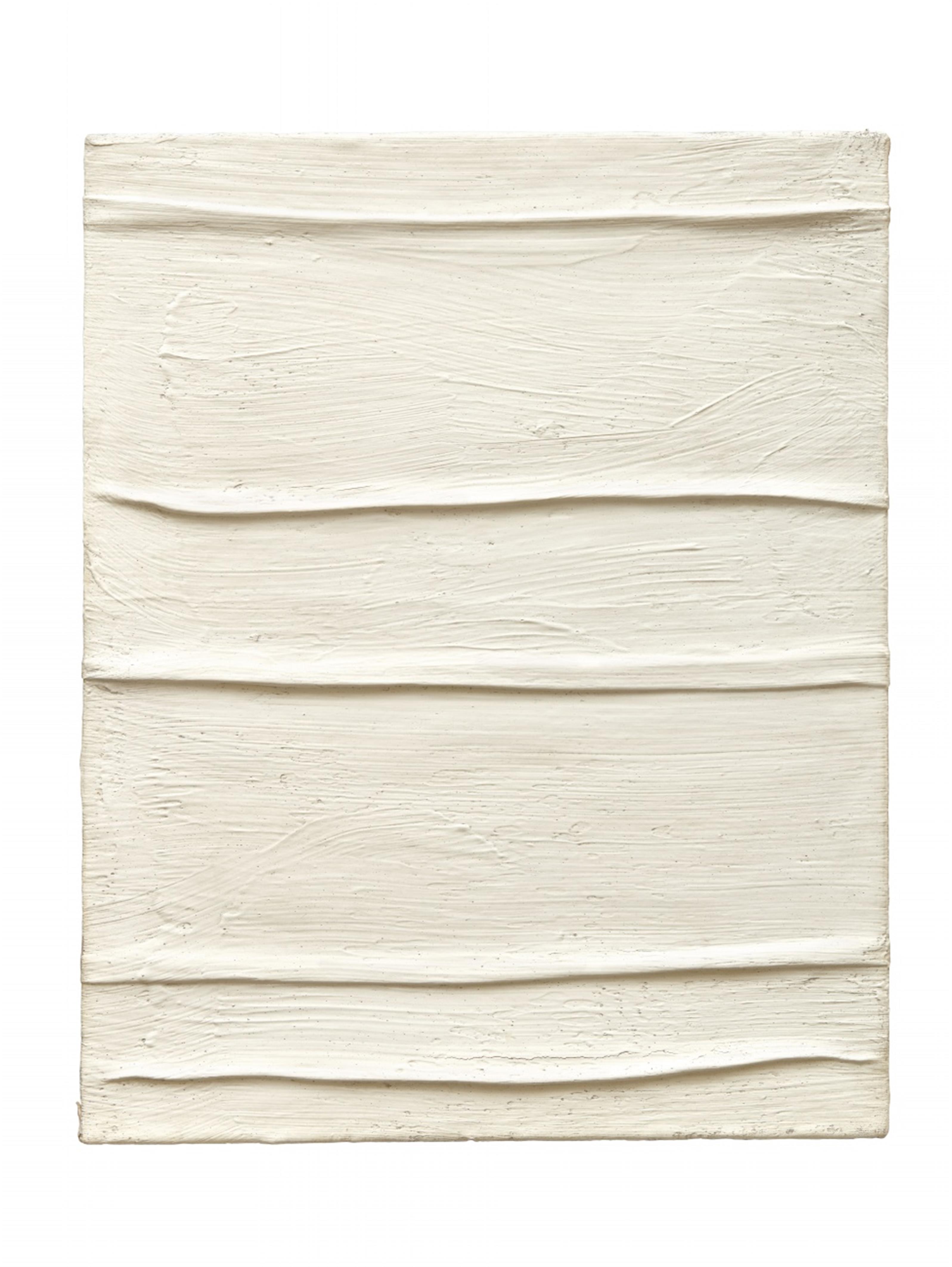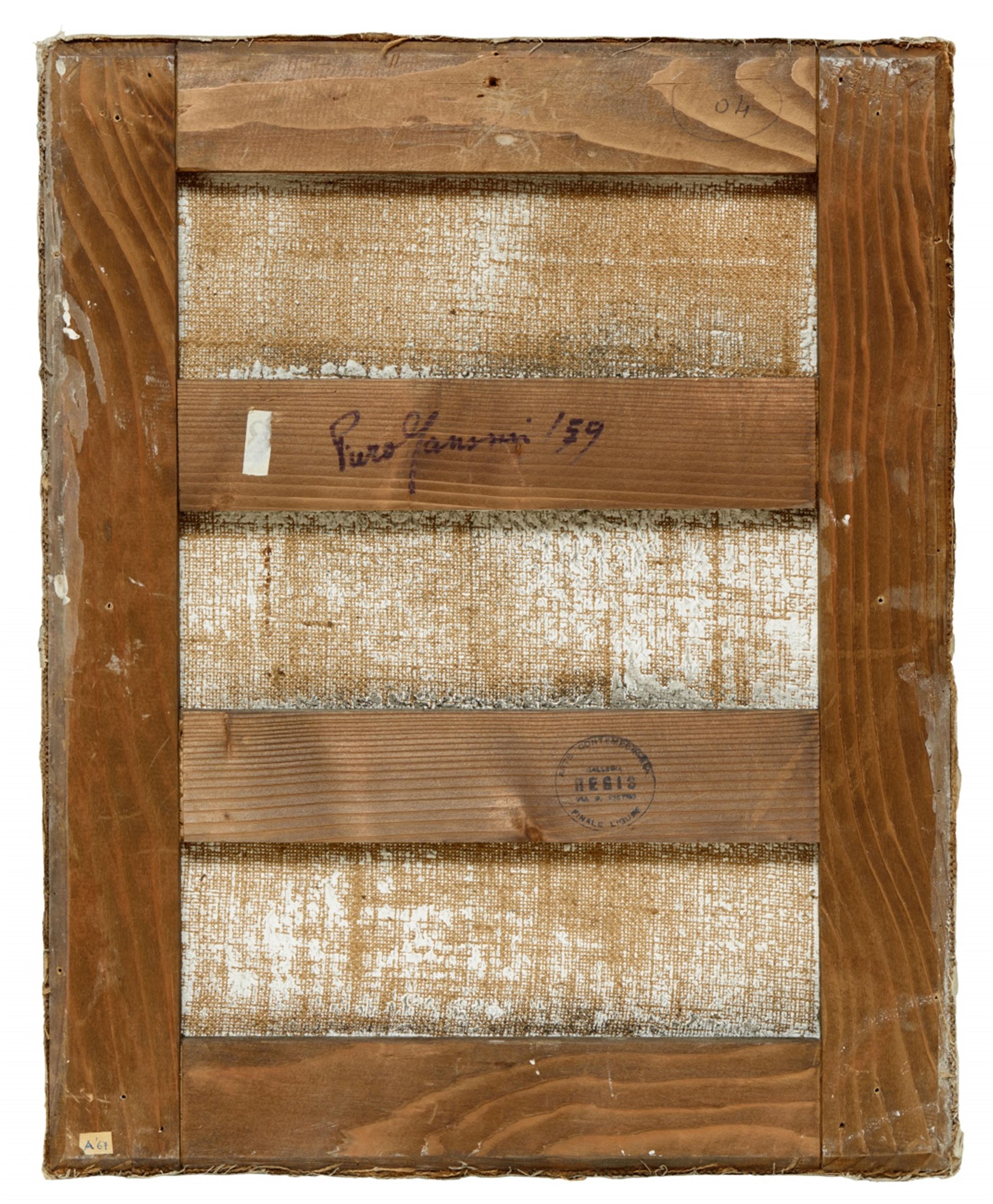Piero Manzoni
Achrome
1958
Folded canvas and kaolin. 50 x 40 cm. Framed in plexiglass case. Inscribed "PieroManzoni `59" in an unknown hand verso on stretcher. - Minor traces of age.
Piero Manzoni (1933-1963) is without doubt one of the most important artists of the Italian post-war period. Only a few years remained for him to develop his multi-layered, scintillating and provocative work, at times bewildering for his viewers, and to initiate the radical change of art around 1960 with his far-reaching contribution. Everybody had heard of the extreme provocation of society at that time with the practical 90 cans of merda d'artista at 30 grams each - artist shit! However, the concept of provocation was only an artistic means; with Lucio Fontana or Yves Klein Manzoni opened up a new chapter of the Avant-Garde: he expanded theories and trends in abstract painting by conceptual art and performance, a challenging visual language that emancipated itself with a completely independent formulation. Manzoni “stepped” into the world in order to realise his full potential, to elaborate images or an aesthetic structure through related matter and to become physically engaged with his personal habitus and behaviour. Manzoni acted, as did Yves Klein, on the borderline between daily art and daily life. Both artists used their bodies, played with the sound of their voices to be completely authentic, 'just to be', said Piero Manzoni.
A formal principle that was ultimately also used by many artists in many different ways, for example in Germany by the ZERO artists Heinz Mack, Otto Piene and Günther Uecker or those who cross the paths of ZERO, in Italy with Lucio Fontana, Piero Manzoni, Enrico Castellani, Gianni Colombo and others, in France with Yves Klein, François Morellet and Jesús Rafael Soto or in the Netherlands with Armando and Jan J. Schoonhoven to name but a few. In overcoming the informal gesture, these artists seek a neutral pictorial form that is not related to any painterly process or to any particular element of painting.
In this respect, Manzoni's earliest works are some kind of “Act of Perception”, for instance scissors or pliers on canvas: image and matter reflect Manzoni's creation of awareness of an everyday reality. Soon he reduced these optical references and dropped them in favour of the work presented here: It is one of the so-called “Achromes”, an extensive series of works - comparable, for example, to the “Concetto Spaziale” by Lucio Fontana - with which Manzoni had been occupied since around 1957. With his own word-creations and the titling of corresponding works, the artist aims at monochrome painting derived from abstract expressionism in the United States, whose complexity he expands with his - achrome - 'non-coloured' but by no means colourless 'folds and structures' on wood, canvas and other supports. According to the Genoa-born art historian Germano Celant cited in the catalogue of the Cologne gallery Karsten Greve, 'the achrome is thus graphic life' that 'can be understood as a unit and as a factor, but also as a homogeneous consequence of a single being that develops in time and in space. At first glance, it may appear different in material and style over the years, but its form of expression continues; it is an expression of a living dynamic presence. One can therefore undoubtedly see the achrome as an actual being, which, like Piero Manzoni, leaves lasting traces.' (Germano Celant, in: Piero Manzoni, Arbeiten von 1957-1961, exhib.cat. Galerie Karsten Greve, Köln 1981, p.41).
The achrome thus accomodates an individual story: the canvas is withdrawn, essential and anonymous at the same time and without colour. Hence, the achrome also offers space for the use of other, typical materials used by the artist: cotton wool, glass fibre, bread, hides, straw, polystyrene and more. 'An image,' said Manzoni, 'is valid insofar as it is total being; it need not say anything, just be; two colours or two hues of the same colour are already in relation, which is alien to the significance of the surface, which alone is unlimited and absolutely dynamic.' (Germano Celant in: Piero Manzoni. 1933-1963 exhib.cat. Städtische Galerie im Lenbachhaus München et al., Munich 1973, unpag.).
With textiles soaked in plaster, or in the case of this picture, in kaolin (fine white porcelain clay), horizontally folded and mounted over a support, Manzoni eludes painting in the classical sense; in its subtle aspect as an object, Manzoni breaks the austerity of an even surface, which, not least in the distribution of light and shadow zones, cleverly animates the surface and opens a per se 'unpainterly' but immensely sensual gesture with the different values of a tone.
Catalogue Raisonné
Celant (2004) 185
Battino/Palazzoli (1991) 305 BM
Celant (1975) 65 cg
Provenance
Galleria Regis, Finale Ligure (stamp verso); Sesia collection, Turin; Galerie Karsten Greve, Cologne; private possession, North Rhine-Westphalia
Exhibitions
Cologne 1981 (Galerie Karsten Greve), Piero Manzoni, Arbeiten von 1957-1961, exhib.cat.no.16, n.pag. with illus.




